Heard D.E. (editor) Analytical Techniques for Atmospheric Measurement
Подождите немного. Документ загружается.


378 Analytical Techniques for Atmospheric Measurement
standards were prepared by NPL, for all laboratories, to reduce variability associated
with the standard, and analysis was carried out in 12–14 laboratories over four years.
Agreement was generally good for high concentration standard mixtures but disagreement
increased as lower concentration, real air samples were analysed. However, some improve-
ments were achieved over the course of the project. A number of inter-comparisons
between different analytical measurements including GC-FID/ECD/MD, proton transfer
reaction mass spectrometry (PTR-MS) and open path FTIR (OP-FTIR) have been made
(Christian et al., 2004). Good agreement between GC and OP-FTIR and between GC and
PTR-MS was achieved for a number of compounds. However, differences were found
for sticky compounds (e.g. formic acid) and compounds with a low proton affinity
(e.g. formaldehyde) with OP-FTIR and PTR-MS having considerable advantages. It is
important for real samples to take into account the great difference in time resolution
between these methods. In the future, validation of techniques via inter-comparisons of
standards will increase.
Typical single column GC-FID instruments may have relative standard deviations of
the order of 0.2–0.8% for this type of measurement, with an overall level of uncertainty
at the single-figure percentage level arising mainly from gravimetric errors associated
with the preparation of standards. The frequency of calibration is dependent on appli-
cation and detector. An FID is considerably more stable over time than a quadrupole
mass spectrometer, which may require calibration every couple of samples. During an
intensive field campaign, GC-FID systems should be calibrated at least every 100 samples.
Many of the detectors used in GC analysis can give structure-related responses, allowing
a reduced number of analytes to be calibrated. This can reduce calibration time consid-
erably. For example, FIDs give a near-linear increase in response as the carbon number
increases in hydrocarbon chains. The addition of hetero-atoms can cause a deviation
from linearity which can be compensated for using the Effective Carbon Number (ECN).
The ECN relates to an FID response factor as a function of molecular structure, with
different hetero-groups causing varying deviations from linearity. The use of ECN can
be extremely important for the quantification of oxygenated materials which are usually
unstable in gas cylinders, with rapid wall losses and degradation. Carrier gas impurities
can lead to a reduction in separation efficiency with increased background signals and
damage to detectors and columns, in particular if oxygen is present. It is important to
use ultra-high purity gas, and 99.999% helium, or greater, is typically used with both
hydrocarbon and oxygen scrubbers.
8.2.6 Instrument deployment in the field
An important aspect of atmospheric chemistry is the ability to deploy instruments outside
of the laboratory. In order to make measurements of real air samples, GCs must be easily
transported and rapidly installed. The location and accessibility of field sites can vary
greatly and the problems associated will be site dependant.
The availability of gases, cryogens and power is one of the main criteria of fieldwork.
Gases are an integral part of the GC system and gas cylinders are available in a variety
of sizes, usually between 2 and 50 L. In some cases, for example working on an aircraft,

Chromatographic Methods 379
weight is an issue and must be kept to a minimum. Cylinders can be made from
aluminium making them lighter than conventional steel cylinders. The use of commer-
cially available gas generators can reduce the number of gas cylinders required. This is
especially important in locations where gas delivery is not possible. The availability of
cryogens, such as liquid nitrogen, in remote locations makes their use limited and systems
such as Peltier-cooled PTV are more suitable. The power usage of the entire GC set-up
should be kept to a minimum and it is common to use a uninterruptible power supply
(UPS) to avoid damaging shutdown of the instrument during power disruptions. Field
instrumentation incorporating a PTV trap, sample pump, flow control and GC-FID has
a typical power usage of 2 kW (Whalley et al., 2004).
In atmospheric chemistry, the vertical profile of the atmosphere is important. GC
systems have been deployed in a number of different ways to obtain information about
the composition of the atmosphere at varying altitudes. Ground level and boundary layer
measurements can be taken from a number of platforms including conventional and
mobile laboratories, research ships and balloons. A lightweight balloon-borne instrument
has been developed to measure trace gases in the stratosphere and incorporates a series of
Carboxen absorbent tubes which are sampled at different altitudes and analysed on the
ground by a GC system (Danis et al., 2000). Long, wide bore sampling manifolds can be
used to obtain air above ground level allowing the GC to remain in a laboratory on the
ground. For example, the Cape Grim Baseline Air Pollution Station in Tasmania, Australia
(http://www.bom.gov.au/inside/cgbaps/index.shtml) has a very tall tower allowing air to
be sampled at elevations of 3, 10 and 70 m above ground level. To obtain free tropospheric
air without the use of an aircraft, requires a laboratory situated at a high altitude above
sea level. The Jungfraujoch High Altitude Research Station (http://www.ifjungo.ch/) is
situated on a mountain saddle in Switzerland at 3580 m above sea level. Evidence shows
that the Jungfraujoch observatory lies in the free troposphere throughout winter and often
in spring and autumn. A number of atmospheric measurements based on GC systems
have been made at the Jungfraujoch, including hydrocarbons, PAN and halocarbons
(Whalley et al., 2004).
The use of aircraft to obtain a vertical profiles of the atmosphere is becoming increas-
ingly popular. Aircraft allow a large spatial coverage for measurements of atmospheric
species. Flight time is limited, however, and measurements therefore only represent snap
shots in time. Measurements can be made both in situ with an onboard GC and post
analysis with whole air sampling and a ground-based GC system (Blake et al., 1996; Purvis
et al., 2003). Examples of in-flight GC systems are ORAC (Organics by Real Time Airborne
Chromatograph) (Whalley et al., 2004) and PANAK (PAN-Aldehydes-Alcohols-Ketones)
(Singh et al., 2004) which use a series of capillary columns and multiple detectors such
as ECD, PID and RGD.
Gas Chromatography is also used extensively in industry to measure stack emissions,
landfill emissions and to monitor ambient workplace air quality. In general, grab
samples are taken at the emission site using Teflon bags or evacuated containers,
which can be analysed in the laboratory. A development in emissions monitoring
are portable GCs that can be carried by hand or in a backpack. Portable GCs are
available with a variety of detectors including PID, ECD, TCD and MS. These instru-
ments have many applications including hazardous waste site investigation, indoor air
quality and emergency response, for example in the detection of chemical weapons
(http://www.inficonvocmonitoring.com/).

380 Analytical Techniques for Atmospheric Measurement
8.2.7 Examples of applications of chromatography in
atmospheric analysis
Table 8.2 shows a number of typical applications of chromatographic techniques in
atmospheric analysis. Typical sampling lengths, separation mechanisms, detectors and
sensitivity are given, as well as the temporal resolution, indicating the frequency with
which measurements can be taken. The following section highlights a number of examples
of atmospheric measurements obtained using GC.
Figure 8.3 shows a simple GC chromatogram using a WCOT column and an ECD
detector to measure PAN at the Jungfraujoch research station in Switzerland (Whalley
et al., 2004). Using a backflush facility through a pre-column, well-retained analytes were
diverted, allowing only analytes of interest to enter the analytical column (30 m long ×
053 mm i.d., 5% phenyl polysilphenylene-siloxane, 15 m film thickness). Subsequent
separation results in the isolation of PAN from the large air/water peak every 90
seconds. Calibration of the system was performed using gaseous PAN generated by the
photolysis of a mixture of NO
2
with excess acetone, diluted using zero air (Zellweger
et al., 2000).
The measurement of hydrocarbons requires a greater separation capacity than the PAN
GC, where only one analyte was targeted. Figure 8.4 shows the separation of C
1
–C
6
hydrocarbons obtained using a PTV injector, a long PLOT column (50 m long ×053 mm
i.d., Al
2
O
3
modified with Na
2
SO
4
,10m film thickness) and an FID (Bartle & Lewis,
1996). Automation of the procedure, including the use of a H
2
gas generator to provide
carrier and flame gas, allowed the unmanned instrument to produce a chromatogram
Time: 0.080 minutes
0.08
0.06
0.04
Volts
0.02
0.00
0.5 1.0 2.0 3.01.5
Minutes
Peroxyacetylnitrate
2.5
270203.005, Chan A
Figure 8.3 PAN chromatogram, with peroxyacetylnitrate highlighted, taken at the Jungfraujoch research
station, Switzerland. (Fom Whalley et al., 2004, reproduced by permission of the Royal Society of
Chemistry.)

Table 8.2 Typical applications of chromatographic instruments used for gas and condensed phase atmospheric measurements
Description Separation Sample size Detectors Sensitivity RDS
a
Typical
resolution
Operation
b
Permanent
gases, CO,
CH
4
GC packed
columns/molecular
sieves
1–10 mL TCD, FID,
HID
Sub-ppm (TCD) to sub-ppb (HID) Separation 1–10 min UGS
PAN GC open or packed
columns. With pre
column/back flush.
1–10 mL ECD 10 ppt Separation 3 min UGS, AC
Light
hydrocarbons
C
1
-C
6
GC – open tubular
PLOT type
100–3000 mL FID 1–5 ppt Separation 1 hr UGS, AC
DMS GC – WCOT
typically
methylpolysiloxane
100–3000 mL FID, FPD 1–10 ppt Separation 30 min UGS
Isoprene/
terpenes
GC – WCOT
siloxane or
cyclodextrin based
if chiral
100–3000 mL FID, MS 1–10 ppt with FID 10–100 ppt
full-scan quadrupole MS. Sub-ppt
with quad MS in single ion
monitoring mode. 1–10 ppt with
TOF MS.
Separation 30 min to
1hr
UGS
CFCs GC – WCOT
typically
methylpolysiloxane
100–3000 mL ECD, MS 1–10 ppt with ECD 10–100 ppt
full-scan quadrupole MS. Sub-ppt
with quad MS in single ion
monitoring mode. 1–10 ppt with
TOF MS.
Separation 1 hr UGS
Reactive
halocarbons,
organic
nitrates
GC – WCOT
typically
methylpolysiloxane
100–3000 mL ECD, MS,
Mag sector
MS, CI-MS
1–10 ppt with ECD, sub-ppt with
quad MS in single ion monitoring
mode, sub-0.01 ppt with chemical
ionisiation, sub 0.01 ppt with
magnetic sector MS.
Separation 1 hr UGS, lab

Table 8.2 (Continued)
Description Separation Sample size Detectors Sensitivity RDS
a
Typical
Resolution
Operation
b
Aromatics GC – WCOT
typically phenyl-
methylpolysiloxane
100–3000 mL PID, MS,
FID
1–10 ppt with PID, 1–10 ppt
with FID 10–100 ppt full-scan
quadrupole MS. Sub-ppt with quad
MS in single ion monitoring mode.
1–10 ppt with TOF MS.
Separation 30 min to
1hr
UGS, AC
Carbonyls
(direct)
GC – WCOT or
PLOT
100–3000 mL FID, MS 20–100 ppt with FID, 20–200 ppt
full-scan quadrupole MS. 1–10 ppt
with quad MS in single-ion
monitoring mode. 1–10 ppt with
TOF MS.
Separation 1 hr UGS
Carbonyls
(derivatisation)
GC – WCOT
typically
methylpolysiloxane
5–100 L ECD, MS 20–200 ppt with ECD, 20–200 ppt
full-scan quadrupole MS. 1–10 ppt
with quad MS in single-ion
monitoring mode. 1–10 ppt with
TOF MS.
Sample
collection
Several
hours
AGS, lab
PAH LC – normal or
reverse phase
1–1000 m
3
UV, MS Sub-0.01 ppt with large sample size Sample
collection
Hours to
days
Lab
Acids LC – ion exchange
column
1–1000 m
3
MS ppt level Sample
collection
Hours to
days
AGS, lab
Peroxides LC – reverse phase
with derivatisation
10–100 L FL 10–100 ppt depending on sample
size
Sample
collection
15 min to
1hr
UGS, lab
a
RDS – rate determining step in analysis.
b
Operation: UGS – Unattended ground site, AGS – Attended ground site, AC – Aircraft with attendant ground-laboratory for off-site analysis of Whole Air Sample canisters.
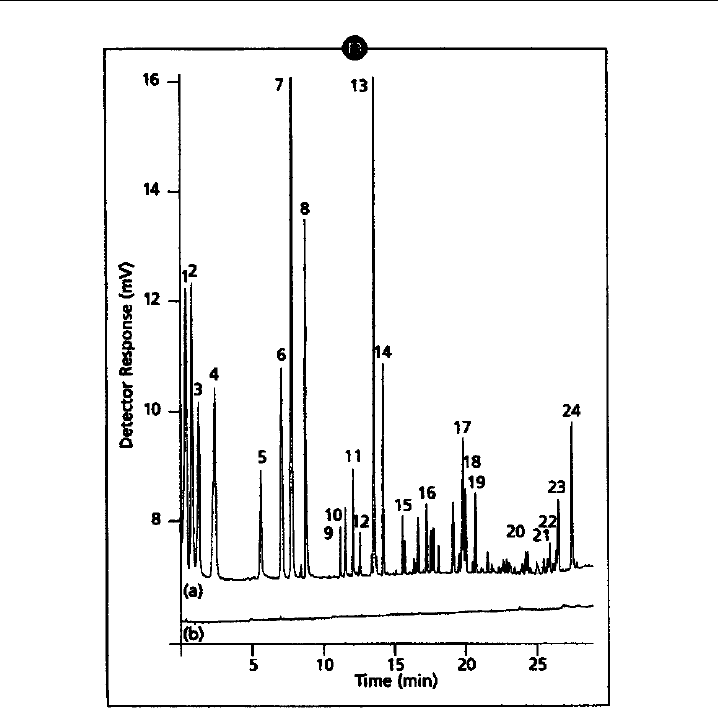
Chromatographic Methods 383
Figure 8.4 Low molecular weight hydrocarbons including methane determined using an on-line
activated charcoal adsorbent trap in a programmed temperature vaporisation injector. Column 50 m
0.53 mm i.d. AL
2
O
3
/Na
2
SO
4
PLOT (Chrompack, Netherlands) 10 m d.f. Desorption temperature was at
16
Cs
−1
from −20 to 400
C, and column temperature programmed from 45 to 200
C. Peaks: 1 =methane,
2 = ethane, 3 = ethene, 4 = propane, 5 = propene, 6 =2-methylpropane, 7 =ethyne, 8 = n-butane, 9 =
trans-2-butene, 10 = 1-butene, 11 =isobutene, 12 =cis-2-butene, 13 =2-methylbutane, 14 =n-pentane,
15 = 13-butadiene, 16 = pentenes, 17 = 2-methylpentane, 18 = 3-methylpentance, 19 = n-hexane,
20 =methyl hexanes and hexenes, 21 =heptane, 22 =methylcyclopentane, 23 =benzene, 24 =toluene.
(Reproduced with permission from Bartle and Lewis, 1996.)
every 45 minutes. Using the same instrumentation with a WCOT column (60 m long ×
053 mm i.d., 100% dimethyl polysiloxane, 3 m film thickness), which is more suited to
the separation of heavier weight analytes, allows the separation of C
5
–C
10
hydrocarbon
species in the atmosphere, as shown in Figure 8.5 (Lewis et al., 1996). Using a dual
column approach in one instrument facilitates the measurement of the whole range of
C
1
–C
10
hydrocarbons in a single analysis.
The analysis of oxidised organics in the atmosphere gives important information on the
age and processing of an air mass. Figure 8.6 shows a chromatogram of a C
2
–C
5
o-VOCs
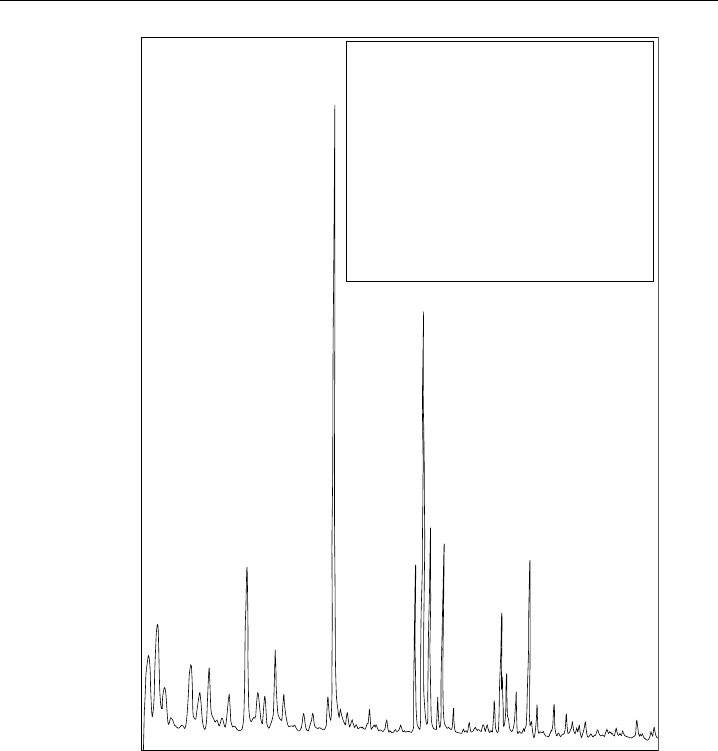
384 Analytical Techniques for Atmospheric Measurement
0.000
5
5
Concentration 2.88 ppbV in air
1
4
6
7
8
9
10
11
12
15
16
17
19
20
25
28
36
35
34
33
32
31
30
29
21
22
23
26
27
3
10 15 20
Minutes
25 30 35 40
0.002
0.004
0.006
0.008
0.010
0.012
0.014
Volts
18
1. unresolved volatile material
2. hexane
19. styrene
20. o-xylene
21. nonane
22. iso propyl benzene
26. 1,3,5 trimethyl benzene
27. O-ethyl toluene
28. 1,2,4 trimethyl benzene
29. decane
31. indane
36. dodecane
35. naphthalene
34. 1,2,3,5 tetra methyl benzene
30. 1,2,3 trimethyl benzene
23. propyl benzene
24. m-ethyl toluene
25. p-ethyl toluene
3. methyl cyclopentane
4. 2,4 dimethyl pentane
5. benzene
6. 2 methyl hexane
7. 3 methyl hexane
8. 2,2,4 trimethyl hexane
9. heptane
10. methyl cyclohexane
11. 2,4 and 2,5 dimethyl hexane
12. 2,2,3 trimethyl pentane
13. toluene
14. 2 and 4 methyl heptane
15. 3 methyl heptane
16. octane
17. ethyl benzene
18. m and p xylene
32. 1,4 dimethyl 2 ethyl benzene
33. diemethyl ethyl benzenes
and undecane
Figure 8.5 Aromatic hydrocarbon species determined using an on-line Tenax™ TA adsorbent trap in a
programmed temperature vaporisation injector. Column 60 m 0.53 mm i.d. 100% methyl polysiloxane
3 m d.f. (Restek RTX-1) Desorption temperature was at 16
Cs
−1
from 0 to 220
C, and column temperature
programmed from 35 to 240
C. (Reproduced with permission from Lewis et al., 1996.)
analysis obtained at the Mace Head Atmospheric Research Station (MHARS), situated
on the West coast of Ireland (Hopkins et al., 2003). The o-VOCs were collected onto
a cooled multi-bed absorbent trap and analysed using a mixed phase capillary column
(10 m ×053mm i.d. Varian CP-LOWOX, 10 m film thickness), designed specifically
for trace oxygenate analysis with a highly polar stationary phase. Analytes were calibrated
using a combination of liquid permeation tubes and gas standards.
Chlorofluorocarbons (CFCs) have been implicated in the destruction of stratospheric
ozone, particularly in the polar regions, leading to the well-known ‘hole in the ozone
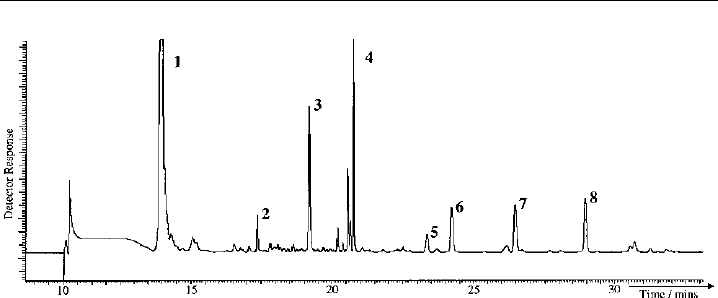
Chromatographic Methods 385
Figure 8.6 Sample chromatograms produced from a LOWOX column where 1 = Aliphatic NMHCs,
2 = benzene, 3 = toluene, 4 = acetaldehyde, 5 = methanol, 6 = acetone, 7 = ethanol, 8 = propanol.
(From Hopkins et al., 2003, reproduced by permission of The Royal Society of Chemistry.)
layer’ discovered in Antarctica. Figure 8.7 shows a chromatogram of CFCs and Halon
species found in clean marine air obtained using both a conventional ECD and an
oxygen-doped ECD. The oxygen-doped ECD can enhance the response of certain halogen
species (e.g. CH
3
Cl, CHF
2
Cl, CH
2
Cl
2
) which have poor responses using conventional
ECD detectors. The discovery of the destructive effects of CFCs has led to international
protocols limiting their use. A number of CFC replacements have been introduced and
their background concentrations have been rising steadily. A GC-magnetic sector MS
instrument has been used to measure the concentration of CFCs and Halon species,
between 1978 and 1995, at the Cape Grim Observatory in Tasmania. Samples were pre-
concentrated onto a cooled glass bead/Tenax™ trap and separated on a PLOT column
(50 m×053 mm i.d. HP Alumina PLOT (KCL)). An example chromatogram is shown in
Figure 8.8, with peaks detected in Single Ion Mode (SIM) at m/z 69, with concentrations
ranging from 80 to 0.1 ppt. Analyte identifications are given and the species detected are
long-lived greenhouse gases, with Halon-1301 being an important ozone depleter.
In marine environments, elevated levels of volatile halocarbons are found in the
atmosphere, which are emitted from marine sources such as seaweed and phytoplankton.
Many of the most important halocarbons have very unique mass spectra, making their
analysis particularly suited to GC-MS. Using the mass spectrometer in SIM, over specific
retention ranges, gives maximum sensitivity. The GC-MS chromatogram shown in
Figure 8.9 was obtained at the Mace Head station, which is situated in a coastal region.
The low concentration species have been extracted to show the total speciation achieved.
Data of this type can give important information about the air–surface partitioning
occurring within the marine boundary layer.
As described earlier, the urban atmosphere contains a highly complex mixture of
organic compounds, in both the gas and the aerosol phase. GC ×GC with FID detection
has been used to separate the C
6
–C
14
organic compounds at a roadside site in Leeds, UK
(Hamilton & Lewis, 2003). Using a primary volatility-based column (50 m ×032 mm i.d.
100% dimethylpolysiloxane, 4 m film thickness), followed by a secondary polarity-based
separation (25m×010 mm i.d. 50% phenyl polysilphenylene-siloxane, 01 m film
thickness) and a valve modulator, gives significant improvement in separation capacity.
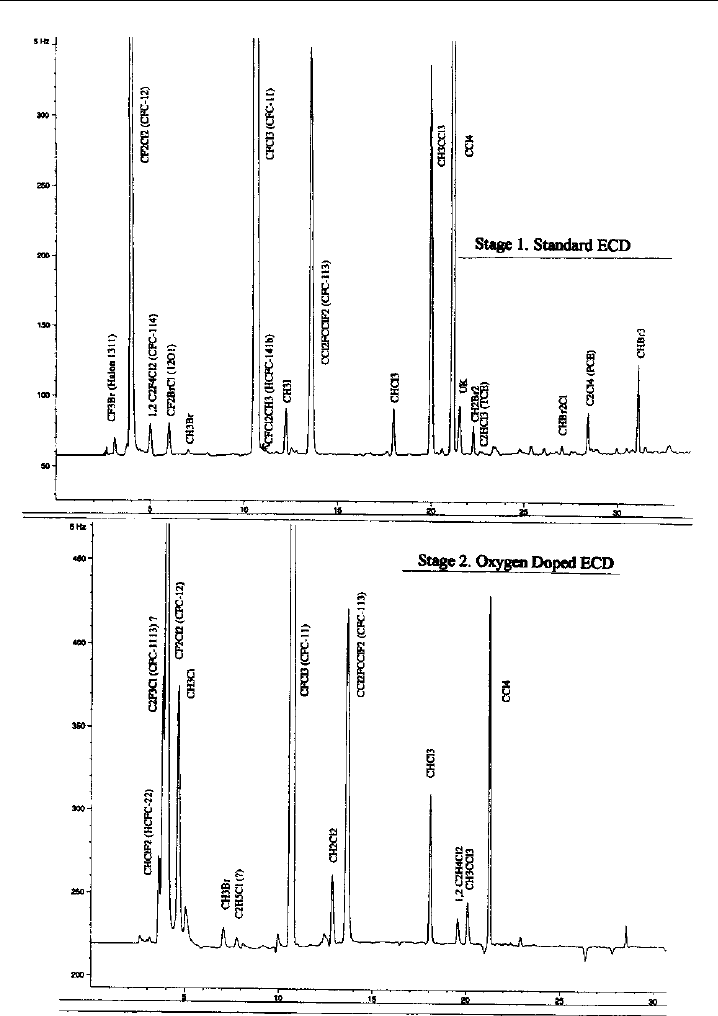
386 Analytical Techniques for Atmospheric Measurement
Figure 8.7 CFCs and Halon species in clean marine air determined using an on-line Carbosieve micro
adsorbent trap and direct injection to capillary GC. Detection by dual ECD/oxygen doped ECD. 60 m,
0.33 mm i.d., 1 m film DB-1 (J & W). (By courtesy of M. Bassford and P.G. Simmonds, University of
Bristol, Cantocks Place, Bristol.)
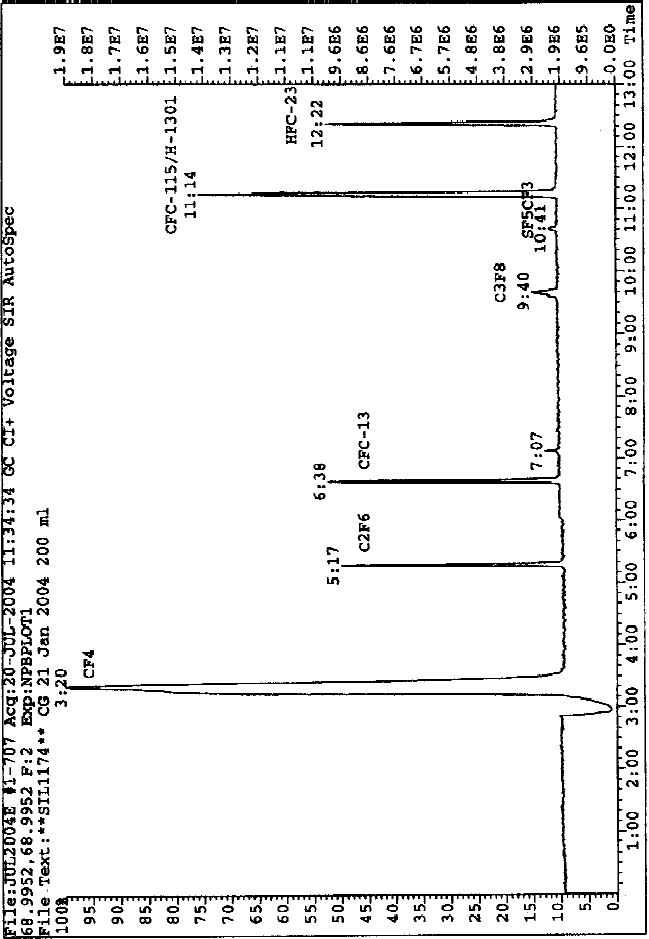
Figure 8.8 Long-lived greenhouse gases observed at the Cape Grim Observatory, Tasmania using a GC/sector MS with SIM at m/z 69. Samples were pre-concentrated
onto Tenax™/glass bead traps and separated using an Al
2
O
3
/KCl PLOT column. (By courtesy of D. Oram, University of East Anglia, UK.)
